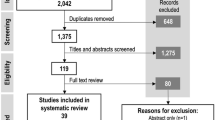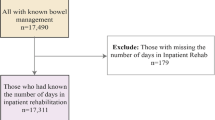Abstract
Study design:
A cross-sectional postal survey.
Objectives:
To describe defecation stimulation methods and their outcomes, and to investigate the impact of bowel dysfunction on the quality of life (QoL) in community-dwelling persons with spinal cord injury in South Korea.
Setting:
Community-based, Korea.
Methods:
A cross-sectional postal survey was conducted. Questionnaires were sent to 459 chronic spinal cord injury (SCI) patients who were registered as members of the Korean Spinal Cord Injury Association. Defecation stimulation methods and their outcomes, the impact of bowel dysfunction on the QoL were investigated.
Results:
A total of 388 subjects (44.5±10.8 year of age; men, 76.0%; duration of time since the onset of SCI, 14.2±9.5 years) responded. Bowel-related general, social and home QoL deterioration was found in >60%. Suppositories (Supp) were most frequently used, followed by digital rectal stimulation (DRS). The mini enema (ME), which is exclusively used in Korea, was utilized in 18.8%. A defecation time of 30 min was more frequently reported in patients who stimulated defecation with Supp than in those who used DRS.
Conclusions:
The use of MEs and warm-water irrigations were newly identified in Korea. Bowel care-related factors that greatly deteriorate the QoL were fecal incontinence, time in one defecation >60 min, perianal skin problem, flatus incontinence and hemorrhoids. Alleviating these factors might help to improve the QoL. In particular, stimulation methods to reduce time for defecation might be recommended to persons with chronic SCI.
Similar content being viewed by others
Log in or create a free account to read this content
Gain free access to this article, as well as selected content from this journal and more on nature.com
or
References
Branagan G, Tromans A, Finnis D . Effect of stoma formation on bowel care and quality of life in patients with spinal cord injury. Spinal Cord 2003; 41: 680–683.
Coggrave M, Norton C, Wilson-Barnett J . Management of neurogenic bowel dysfunction in the community after spinal cord injury: a postal survey in the United Kingdom. Spinal Cord 2009; 47: 323–330.
Krogh K, Christensen P, Sabroe S, Laurberg S . Neurogenic bowel dysfunction score. Spinal Cord 2006; 44: 625–631.
Roach MJ, Frost FS, Creasey G . Social and personal consequences of acquired bowel dysfunction for persons with spinal cord injury. J Spinal Cord Med 2000; 23: 263–269.
American Spinal Cord Injury Association. Clinical practice guidelines: neurogenic bowel management in adults with spinal cord injury. Spinal Cord Medicine Consortium. J Spinal Cord Med 1998; 21: 248–293.
Han TR, Kim JH, Kwon BS . Chronic gastrointestinal problems and bowel dysfunction in patients with spinal cord injury. Spinal Cord 1998; 36: 485–490.
World Health Organization. International Classification of Functioning, Disability and Health (ICF), 2001, Committee for Korean Translation and Publishing of ICF (trans), Ministry of Health and Welfare: Seoul, Korea, 2004, pp129–130.
Christensen P, Bazzocchi G, Coggrave M, Abel R, Hultling C, Krogh K et al. A randomized, controlled trial of transanal irrigation versus conservative bowel management in spinal cord-injured patients. Gastroenterology 2006; 131: 738–747.
Faaborg PM, Christensen P, Kvitsau B, Buntzen S, Laurberg S, Krogh K . Long-term outcome and safety of transanal colonic irrigation for neurogenic bowel dysfunction. Spinal Cord 2009; 47: 545–549.
Emmanuel A . Review of the efficacy and safety of transanal irrigation for neurogenic bowel dysfunction. Spinal Cord 2010; 48: 664–673.
Christensen P, Bazzocchi G, Coggrave M, Abel R, Hulting C, Krogh K et al. Outcome of transanal irrigation for bowel dysfunction in patients with spinal cord injury. J Spinal Cord Med 2008; 31: 560–567.
Liu CW, Huang CC, Yang YH, Chen SC, Weng MC, Huang MH . Relationship between neurogenic bowel dysfunction and health-related quality of life in persons with spinal cord injury. J Rehabil Med 2009; 41: 35–40.
Lynch AC, Wong C, Anthony A, Dobbs BR, Frizelle FA . Bowel dysfunction following spinal cord injury: a description of bowel function in a spinal cord-injured population and comparison with age and gender matched controls. Spinal Cord 2000; 38: 717–723.
Faaborg PM, Christensen P, Finnerup N, Laurberg S, Krogh K . The pattern of colorectal dysfunction changes with time since spinal cord injury. Spinal Cord 2008; 46: 234–238.
Krogh K, Perkash I, Stiens SA, Biering-Sorensen F . International bowel function basic spinal cord injury data set. Spinal Cord 2009; 47: 230–234.
Glickman S, Kamm MA . Bowel dysfunction in spinal-cord-injury patients. Lancet 1996; 347: 1651–1653.
Correa GI, Rotter KP . Clinical evaluation and management of neurogenic bowel after spinal cord injury. Spinal Cord 2000; 38: 301–308.
Del Popolo G, Mosiello G, Pilati C, Lamartina M, Battaglino F, Buffa P et al. Treatment of neurogenic bowel dysfunction using transanal irrigation: a multicenter Italian study. Spinal Cord 2008; 46: 517–522.
Holzer B, Matzel K, Schiedeck T, Christiansen J, Christensen P, Rius J et al. Do geographic and educational factors influence the quality of life in rectal cancer patients with a permanent colostomy? Dis Colon Rectum 2005; 48: 2209–2216.
Stone JM, Nino-Murcia M, Wolfe VA, Perkash I . Chronic gastrointestinal problems in spinal cord injury patients: a prospective analysis. Am J Gastroenterol 1990; 85: 1114–1119.
Worsoe J, Christensen P, Krogh K, Buntzen S, Laurberg S . Long-term results of antegrade colonic enema in adult patients: assessment of functional results. Dis Colon Rectum 2008; 51: 1523–1528.
Author information
Authors and Affiliations
Corresponding author
Ethics declarations
Competing interests
The authors declare no conflict of interest.
Rights and permissions
About this article
Cite this article
Kim, J., Koh, E., Leigh, J. et al. Management of bowel dysfunction in the community after spinal cord injury: a postal survey in the Republic of Korea. Spinal Cord 50, 303–308 (2012). https://doi.org/10.1038/sc.2011.124
Received:
Revised:
Accepted:
Published:
Issue date:
DOI: https://doi.org/10.1038/sc.2011.124
Keywords
This article is cited by
-
Effect of neurogenic bowel dysfunction symptoms on quality of life after a spinal cord injury
Journal of Orthopaedic Surgery and Research (2023)
-
Are micro enemas administered with a squeeze tube and a 5 cm-long nozzle as good or better than micro enemas administered with a 10 cm-long catheter attached to a syringe in people with a recent spinal cord injury? A non-inferiority, crossover randomised controlled trial
Spinal Cord (2022)
-
Barriers and facilitators to changing bowel care practices after spinal cord injury: a Theoretical Domains Framework approach
Spinal Cord (2022)
-
Clinical recommendations for use of lidocaine lubricant during bowel care after spinal cord injury prolong care routines and worsen autonomic dysreflexia: results from a randomised clinical trial
Spinal Cord (2020)
-
Application of transanal irrigation for patients with spinal cord injury in South Korea: a 6-month follow-up study
Spinal Cord (2013)



